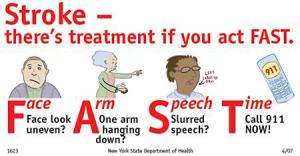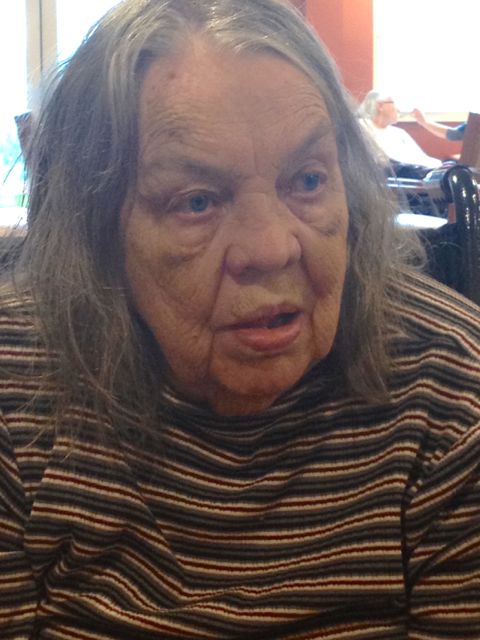
by Diane Masson | Mar 29, 2015

Act FAST
My sister-in-law witnessed my father-in-law, Bill, having a mini-stroke (TIA) this week. What a heartbreaking story. She was sitting with him in the living room and noticed his face droop on one side. Then his speech became garbled. It was over in two minutes and he could talk fine again. He had no idea it happened.
She was understandable traumatized and wanted to talk about it. My husband and I are 1000 miles away and applaud her efforts to care for my father-in-law in her own home till he passes. We both think she is a saint.
Through my Internet research it says a TIA is a mini-stroke. TIA’s can be warnings that a bigger stroke can be coming. In my mom’s case, she has had so many TIA’s that she has been diagnosed with vascular dementia. I have never personally witnessed a TIA with my mom.
I guess you could say we were lucky it was only a TIA with Bill. Unfortunately, my father-in-law is now on hospice. Hospice is comfort care, so the goal is no hospitals or ambulances if at all possible.
Every caregiver, family member and senior living professional should know the signs of a stroke and what to do. Stokes can cause permanent damage. If you get someone to a hospital in time, it can reverse the affects of the stroke. Go to www.strokeassociation.org to learn more. They say you should act FAST! FAST stands for: face drooping, arm weakness, speech difficulty and time to call 911.
Have any of you encountered or witnessed a TIA or stroke?
Diane Twohy Masson’s new guide book for seniors, “Your Senior Housing Options,” is available on Amazon.com with a 5-star rating. It reveals a proactive approach to navigating the complex maze of senior housing options. It will help you understand the costs and consequences of planning ahead or waiting too long. Learn firsthand tips from someone who is currently advocating for three aging parents.
Among the thousands of seniors she and her teams have assisted in finding the right senior living community, the most difficult case has been helping her own parent. Masson spent two years exploring senior housing options with her mother before finding the ideal Continuing Care Retirement Community for her. After eight years in this independent living setting, she helped her mother transition into an assisted living community. Seven years later, even as a senior housing expert, Masson struggled with the decision to move her mother into a skilled nursing community.
More related articles by Diane can be found at Tips2Seniors.com or like Tips 2 Seniors on Facebook.
Diane Twohy Masson has worked in senior housing since 1999. She is an award-winning certified aging services professional and the author of Senior Housing Marketing: How to Increase Your Occupancy and Stay Full for senior living professionals.

by Diane Masson | Mar 22, 2015

Memory Care and Assisted Living Costs
Finding an affordable memory care or assisted living community can be a daunting task. Even this senior housing guru had to plan strategic questions before touring four memory care communities for my mother-in-law. See the questions HERE.
My husband and I flew 1000 miles to Seattle. We only had two days to tour memory care communities in the Seattle area. This required researching the Internet, calling former senior housing colleagues for recommendations and scheduling tours before we left. The timing was tricky because our limited time included visiting with my husband’s mom.
My husband created a spreadsheet to compare costs between these four memory care communities. The pricing is so complex that even someone working in the senior living field (like me) had trouble figuring out the monthly cost for my mother-in-law.
Care points, care levels or all inclusive costs?
Most assisted living and memory care communities seem to have a charge for room and board, then additional costs for care. Pricing can be very gray and feels like an illusion of smoke and mirrors. Care costs can be priced on a point system or a level system.
My mother-in-law, Amy, was assessed at 223 points at her current memory care community. Care costs varied dramaticly. Some of our tour guides were actually guessing what level of care or point total she might be, before a nurse could assess her. This is what makes pricing difficult to compare. The community recommends that you to move her in and then they will figure out the monthly price. Sigh…
Here were the room and board costs of four memory care communities in the Seattle area (these prices do not reflect care costs):
Community A Private Room: $2,330
Community B Private Room: $5,095
Community C Private Room: $4,050
Community D Private Room: $4,137
Room and board costs for a shared room in memory care are less:
Community A Shared Room: $1,050
Community B Shared Room: $4,895
Community C Shared Room: $2,850
Community D Shared Room: $3,837
So let’s try to figure out care costs:
Community A has four care levels: Amy’s current care level two (estimate) – $3,860
Community B has five care levels: Amy’s current care level three (estimate) – $2,595
Community C uses care points: Daily charge .54 a point x 223 = $3,613
Community D uses care points: Daily charge .73 a point x 223 = $4,884
So the price is so high, we decide to consider a shared room. So let’s add the shared room with the care costs to see what Amy would be charged each month:
Community A – Amy’s monthly total: $4,910
Community B – Amy’s monthly total: $7,490
Community C – Amy’s monthly total: $6,463
Community D – Amy’s monthly total: $8,721
Each place said it would reassess Amy in two weeks. They implied the price would bump down, but it might bump up in price. Right?!!? So that led us to ask what could be the maximum cost for Amy’s care in a shared room?
Community A – Amy’s maximum cost: $6,820
Community B – Amy’s maximum cost: $9,045
Community C – Amy’s maximum cost: $9,006
Community D – Amy’s maximum cost: $12,159
Community D was priced the highest, but it also had the highest staff ratio and was a drop-dead gorgeous new building. We had to eliminate it due to Amy’s finances. Community A was priced the lowest and had a wait list. It was cheaper, but gross and we saw a low staff ratio. So that left us Community B or C. Community B had a care level pricing and was brand new. Community C was based on care points and was a dated older community. This is where our spreadsheet came in handy.
The bottom line for the family: Amy’s care was more important than a new community that looked great walking in the lobby. We felt Community C had outstanding personnel! Every single person greeted us on our tour. They painted the picture of Amy’s reality, but explained how they would provide the best care in a homey environment. We felt they were experienced enough to correct Amy’s medications that had been over prescribed at the hospital (You can read about drugging and diapering seniors HERE.).
So Community C will initially cost the family around $6,000 a month, plus the one time community fee. They assessed Amy the same day we toured (another example of excellent service) and determined that 223 points was too high. Her new assessment is less than 200 points.
One-Time Community Fee
Assisted living and memory care communities typically have a community fee (one time) when someone moves in. Here were the memory care community fees for the four places we toured:
Community A: $2,500
Community B: $4,895
Community C: $6,500
Community D: $10,433
It’s complicated to compare senor-housing options; I hope this information can help you. Some other assisted living and memory care communities are all inclusive and only charge extra for incontinence care. Do your own research. Cheaper does not always mean better. Look beyond the superficial newness to the quality of the nursing and caregiver staff. Don’t forget to ask about turnover of staff. Community C has two key staff that have worked over 10 years for the company.
What have you encountered?
I haven’t even discussed who can afford these expensive prices? What about poverty level seniors? What happens when a senior runs out of money? Why is Medicaid almost impossible to find at licensed assisted living communities? These questions are addressed in my new book, “Your Senior Housing Options.” It is available on Amazon.com with a 5-star rating.

by Diane Masson | Mar 15, 2015

My sedated mother-in-law
Apparently drugging and diapering seniors in the hospital is common knowledge in higher levels of senior living care, such as assisted living, memory care and skilled nursing?!!?
This is horrifying new knowledge for me. I am all about exposing dirty secrets in my new book, “Your Senior Housing Options.” So let me share what I have recently learned through my mother-in-law’s experience. My mother-in-law, Amy, has dementia and was cared for by my father-in-law for the last several years. Three days after he had a heart attack, she became psychotic. My husband and I had to hire a geriatric care nurse to help her because we live 1000 miles away. Learn more of the story HERE.
It took over two weeks to get Amy admitted to the hospital (it’s a long story). Initially, we were relieved that she was going to get the psychotropic drugs she needed. Since Amy was in crisis mode, we didn’t dwell on her being diapered because of diarrhea. She’d had colon cancer 25 years ago and has self-managed her own colon care with diarrhea medications for years.
Costs for Incontinence
As she was in the process of transferring to a secured memory care, I was promised that they would be diligent about avoiding Amy’s trigger foods (that cause the diarrhea). My assumption was that she would surely regain continence again. This was vitally important, because incontinence can cost an additional $300 to $1,000 per month depending upon the assisted living community.
My Mother-in-law Was Over Sedated
We flew to Seattle to see Amy and to help find a reasonably priced memory care community for her. She was so sedated that she could not keep her eyes open and kept saying, “I am so tired,” over 25 times. She apologized that she needed to lie down and take a nap. She was in a wheelchair and needed a one person transfer to get in bed. What?!!? One month ago, she was walking around. My husband and I were shell-shocked to see her so drugged and lethargic. We talked to the memory care community and they said they would contact the doctor immediately to reduce the medications.
The next day, we arrived to see Amy again. After being told that she was engaged and walking around, we found her asleep in a wheelchair in the middle of a singing class. It was heart wrenching to witness. Again, she spoke of her sleepiness.
Advocacy is Key for a Senior with Dementia
The administrator came over and had the nerve to tell me, “My team feels we should follow the doctor’s recommendation of not changing Amy’s drugs for one or two months.” What?!!? I asked the nurse, “Do you see Amy’s lip trembling?” She said, “Yes.” I inquired if she saw both of Amy’s arms shaking too. She agreed. Then I said, “Do you see how sleepy she is and how her eyes can’t stay open?” “Yes,” she said. I simply said, “That is not Amy.” “Oh,” she said, “Then she is on too much medication.” “Exactly,” I said and was relieved that someone finally understood.
It took till the next evening for the community to contact her doctor and reduce one of her medications by half.
At this point Amy has been drugged and diapered for five weeks (between the hospital and the memory care community).
Conclusion:
That was five weeks too much of over drugging and diapering a senior with dementia. Can she ever come back and resume continence again? Will she be able to walk freely like she used to in her own home? My own mother was given psychotropic medications in skilled nursing care. Four months later, her walking had decreased dramatically; a few months later she became wheelchair bound for life. Was it the drugs or aging decline? I will never know, but I want to protect my mother-in-law from being over sedated and permanently wheelchair bound. I hope she has a fighting chance to walk again.
Drugs as Restraints?
I have talked with several administrators of assisted living and skilled nursing communities. They say it is common for seniors to arrive from the hospital drugged and diapered. The hospital can’t use restraints, so they use drugs as restraints. My mother-in-law was prescribed haloperidol twice a day and trazodone four times a day as needed. Why did the hospital dope her up so much? It is an advocacy nightmare to get it reversed.
What have you encountered? Has you ever witnessed the sedation and diapering nightmare of a senior?
Diane Twohy Masson’s new guide book for seniors, “Your Senior Housing Options,” is available on Amazon.com with a 5-star rating. It reveals a proactive approach to navigating the complex maze of senior housing options. It will help you understand the costs and consequences of planning ahead or waiting too long.
More related articles by Diane can be found at Tips2Seniors.com or like Tips 2 Seniors on Facebook.
Diane Twohy Masson has worked in senior housing since 1999. She is an award-winning certified aging services professional and the author of Senior Housing Marketing: How to Increase Your Occupancy and Stay Full for senior living professionals.
Among the thousands of seniors she and her teams have assisted in finding the right senior living community, the most difficult case has been helping her own parent. Masson spent two years exploring senior housing options with her mother before finding the ideal Continuing Care Retirement Community for her. After eight years in this independent living setting, she helped her mother transition into an assisted living community. Seven years later, even as a senior housing expert, Masson struggled with the decision to move her mother into a skilled nursing community.

by Diane Masson | Mar 2, 2015

Diane and Chris Flying 1000 Miles to Look for Affordable Memory Care for my Mother-in-law
My mother-in-law is currently in a secured memory care community. The price is very high – $6750 for 30 days of respite care. If we don’t move her within two weeks, the community fee for a permanent stay will be $10,000 and her monthly fee will be $9,000 a month. Are you kidding me? Who can afford this?
She was living in her own home six weeks ago, but a crisis you can read about HERE has left her adult children scrambling to find a permanent solution for my mother-in-law.
My husband, Chris, and I work in the senior housing profession, so who is better than us to evaluate the choices. We flew 1000 miles yesterday to be the experts on the ground in Seattle. We are going to visit three memory care communities today and one or two tomorrow. The best way to evaluate and compare retirement communities is in a short span of time. The crème always rises to the top.
We can’t base our decision on what the community looks like, the size of the rooms or the wonderful sales person. We are going to dig deeper and ask the following questions of each memory care community:
- What is the staff turnover? We want to see longevity of staff – particularly in the administrator, nurse, caregivers and possibly the chef.
- Do the staff and residents look happy? We will talk to some of each.
- What will be my mother-in-laws quality of life? What programming is offered? How often does live entertainment come in the building? How will they minimize her anxiety?
- How many hours does the nurse work per day? Twenty-four hours will always be the best answer, but you get what you pay for.
- What is the procedure if my mother-in-law falls? When my mom was in an assisted living community with dementia, every fall led to a terrifying emergency room (ER) visit that was stressful for her. If a nurse is on shift around the clock, it may save my mother-in-law from this stress. If the fall happens at 2:00 am and only a caregiver is on staff, the call to 911 will almost always lead to the terrifying ER visit.
- Do doctors come and visit my mother-in-law here or does she have to be driven to her doctor? Who will do that? Will someone accompany her? What are the costs?
- We will discuss my mother-in-law’s dietary needs and meet the chef. When my mother-in-law was in the hospital, she became incontinent. We hope it is not permanent and assume the diarrhea was from feeding her too many raw vegetables and fruit. She has not eaten those in years because of too much radiation after colon cancer. So it is important that we advocate for her in this regard. Just incontinence can cost an additional $1,000 a month.
- What is the initial community fee? What is the current monthly cost for room, board and care? What is the maximum cost it could potentially be? What are the additional costs? What have we not asked that could cost extra? What happens when someone is broke and can’t pay these hefty fees? We need to find out if the memory care community charges for my mother-in-law’s care by points, levels of care, or is all-inclusive. Pricing can be very grey and it is easy to be confused. Even us experts will have to see beyond the sales “smoke and mirror” answers.
- What is the history of their year over year monthly increases? We can’t just look at affordable costs today, but what if my mother-in-law lives for years?
- Is the room furnished? Do we just bring personal affects? Do we need to go buy a twin bed, TV or special chair?
- How do they handle hearing aids and glasses? My mother-in-law has two hearing aids that she has not used in six weeks.
- What is their procedure in contacting the family to give updates or let us know of a change in our loved one’s health?
- Is there anything that we should have asked but did not?
We will look at the entire memory care community space, her possible room and the outside walking area. I will keep you posted on our family evaluation and pricing for these communities. Hopefully, sharing my experiences and tips can help you too.
Diane Masson’s new guide book for seniors, “Your Senior Housing Options,” will be available next week on Amazon.com. If you sign up for my weekly newsletter on the right side of this blog, you will be notified when this valuable resource can be purchased. Check out my new website: Tips2Seniors.com or please follow me on Facebook.
Diane Twohy Masson is the author of “Senior Housing Marketing – How to Increase Your Occupancy and Stay Full,” available at Amazon.com with a 5-star rating. The book is required reading at George Mason University as a part of its marketing curriculum. Within this book, the author developed a sales & marketing method with 12 keys to help senior living providers increase their occupancy. Masson developed this expertise as a marketing consultant, sought-after blogger for senior housing and a regional marketing director of continuing care retirement communities in several markets. She has also been a corporate director of sales and a mystery shopper for independent living, assisted living, memory care and skilled care nursing communities in multiple states. Currently, Masson is setting move-in records as the regional marketing director of two debt-free Continuing Care Retirement Communities in Southern California – Freedom Village in Lake Forest and The Village in Hemet, California. Interestingly, this career started when she was looking for a place for her own mom and helped her loved one transition through three levels of care.
© Marketing 2 Seniors| Diane Twohy Masson 2015 All Rights Reserved. No part of this blog post may be reproduced, copied, modified or adapted, without the prior written consent of the author, unless otherwise indicated for stand-alone materials. You may share this website and or it’s content by any of the following means: 1. Using any of the share icons at the bottom of each page. 2. Providing a back-link or the URL of the content you wish to disseminate. 3. You may quote extracts from the website with attribution to Diane Masson CASP and link https://www.marketing2seniors.net For any other mode of sharing, please contact the author Diane Masson.

by Diane Masson | Feb 8, 2015

Self-destructive, stubborn, selfish or stupid?
Don’t we all know a friend or parent who fits the description of self-destructive, stubborn, selfish or stupid? What do you do? Love them or fight them? How can you help someone who refuses to believe there is a problem? You can’t make a parent be compliant with his or her doctor and you can’t force a senior to move into a higher level of care.
As seniors age, medical problems tend to increase. All sorts of progressive diseases can ravage a senior’s body and create havoc mentally and physically.
Uncooperative Parent?
My friend Grace’s dad has been defiant about his dialysis treatments for seven years. Dialysis is a medical procedure for people whose kidneys are failing. The treatment helps clean your blood and remove toxins from the body. If you refuse treatment you die a painful death.
Richard is supposed to have dialysis three times per week. His pattern of behavior is to refuse treatment till he is in crisis mode and has to be hospitalized. Then he feels good, skips a treatment, toxins build in his body, and he goes back into crisis mode again.
When Richard does not show up for his dialysis, they call his adult daughter who lives 45 minutes away. She used to drop everything including walking away from work to plead with her dad to accept treatment. Sometimes her waterworks of tears would be effective and other times he still refused treatment. Crisis calls every week for seven years is a long time. Anyone of us would be burned out. The police have called my friend and threatened her with elder abuse if she does not get her dad to comply with treatment. Seriously? This man has a right to refuse treatment, even with dementia. How can his daughter be held responsible for his lack of treatment?
- The dad has refused to sign a Power of Attorney (POA).
- The dad has refused to go in the ambulance when it has arrived on numerous occasions to take him to dialysis treatment.
- The dad refused to move to assisted living on the doctor’s recommendation.
- The dad refused to move to skilled nursing care on the doctor’s recommendation.
- The doctor called adult protective services and they have done nothing.
- The daughter asked adult protective services to make her the conservator of her dad and they said no.
This scenario has been going on for seven long years! My heart goes out to my friend. Do you think her dad is self-destructive, stubborn, selfish or stupid? Do you have any thoughts or advice?
Diane Masson’s new guide book for seniors, “Your Senior Housing Options,” will be will be coming soon to Amazon.com. If you sign up for my weekly newsletter on the right side of this blog, you will be notified when my new book becomes available. Check out my new website: Tips2Seniors.com or please follow me on Facebook.
“Your Senior Housing Options,” is dedicated to my mother, whose stories are peppered throughout. Being her advocate for over ten years has taught me to be a better person. My mom has dementia, but I am truly blessed that she still calls me by name. Her smile and joy inspires me to see the positive side of life. It makes me want to reach out and help seniors and their families make better choices today so they can have more secure long-term care plans tomorrow.

by Diane Masson | Nov 16, 2014
 How many of you have worked with a senior who clearly needs to make a move into a senior living community? Maybe she is lonely, not eating nutritiously, no longer driving or desires the social connectivity of liked-minded seniors. The senior is one visit away from selecting an apartment and putting down a deposit. A daughter has already consented that her mom needs the support of your community and is emotional exhausted from helping her mom. The son/brother is coming to town and they want him to put his stamp of approval on this move.
How many of you have worked with a senior who clearly needs to make a move into a senior living community? Maybe she is lonely, not eating nutritiously, no longer driving or desires the social connectivity of liked-minded seniors. The senior is one visit away from selecting an apartment and putting down a deposit. A daughter has already consented that her mom needs the support of your community and is emotional exhausted from helping her mom. The son/brother is coming to town and they want him to put his stamp of approval on this move.
Suddenly, the senior and the daughter become uncommunicative with you. The family is a no-show for the scheduled tour at your retirement community. Your phone calls to reach out to them are unanswered. What happened? Are they okay? Did something happen and maybe the senior is in the hospital?
Most likely the son came into town and sabotaged the deal. “Mom is fine. She does not need to move into an old folks home. It is too expensive. Just keep helping her sis.” Maybe this son is in denial or maybe he is worried that mom might drain his inheritance. Either way, it is a sad circumstance for the mom who will lose out on a better quality of life and the sister who is tired of taking care of mom while raising her own children.
What can you do? How can you handle this situation in the best possible light?
Here is my suggestion: Next time, prepare the mom and sister for the brother’s visit. I would say, “I would love for your son/brother to come see this community and the apartment that you are considering. Just remember, when you tell him that you are thinking of moving here, he might believe you are moving to an old folks home filled with hospital beds. He won’t be able to imagine the lifestyle you will have living here. I think he will be blown away when he sees the 5-star dining room, live entertainment schedule and all the classes that you want to partake in. Let him know that you understand it is hard to believe and ask him to come see it for himself. Let him know how excited you are and that you want him to support your decision.”
Please share in the comment section below how have you handled this situation in the past.
Diane Twohy Masson is the author of “Senior Housing Marketing – How to Increase Your Occupancy and Stay Full.” It is rated by Amazon Editors as one of the best books of 2014 and readers have given it a 5-star rating on Amazon.com. This award winning book is required reading at George Mason University as a part of its marketing curriculum. Within this book, the author developed a sales & marketing method with 12 keys to help senior living providers increase their occupancy. Masson developed this expertise as a marketing consultant, sought-after blogger for senior housing and a regional marketing director of continuing care retirement communities in several markets. She has also been a corporate director of sales and a mystery shopper for independent living, assisted living, memory care and skilled care nursing communities in multiple states. Currently, Masson is setting move-in records as the regional marketing director of two debt-free Continuing Care Retirement Communities in Southern California – Freedom Village in Lake Forest and The Village in Hemet, California. Interestingly, this career started when she was looking for a place for her own mom and helped her loved one transition through three levels of care.
© Marketing 2 Seniors| Diane Twohy Masson 2014 All Rights Reserved. No part of this blog post may be reproduced, copied, modified or adapted, without the prior written consent of the author, unless otherwise indicated for stand-alone materials. You may share this website and or it’s content by any of the following means: 1. Using any of the share icons at the bottom of each page. 2. Providing a back-link or the URL of the content you wish to disseminate. 3. You may quote extracts from the website with attribution to Diane Masson CASP and link https://www.marketing2seniors.net For any other mode of sharing, please contact the author Diane Masson.






